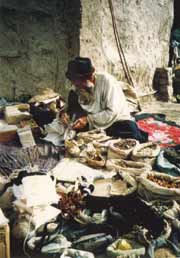"In
the first 1,000 years after Christ, merchants, missionaries,
monks, mendicants and military men travelled on the vast network
of Central Asian tracks that became known as the SILK ROAD
. Linking Europe, India and the Far East, the route passed
through many countries and many settlements, from the splendid
city of Samarkand to tiny desert hamlets. Sogdian merchants
traded in Baltic amber, lapis from Afghanistan, silk from
China and wool from the Mongolian steppes; itinerant Buddhist
monks, Persian Manichaean priests, Zoroastrians, and Nestorian
Christians sought converts among the desert settlers; storytellers,
acrobats, musicians, dancers, courtesans, diviners, pedlers
and miracle-workers offered their wares in the marketplaces
and temple fairs."
Susan Whitfield
 |
TAXILA
(Pakistan) thrived from around 3000 BC to the 16th
century. Excavations have so far revealed three distinct
cities, the earliest dating from around 180 BC To the
north-east is Sirkup originally built by the Bactrian
Greeks, followed by the Scythians, Parthians, and later
by the Kushans, who transformed it into the great centre
of the Gandhara culture. It eventually became the Buddhist
'Holy Land'. The museum houses a magnificent collection
of Gandhara busts of the Buddha, the period which produced
a style of art which evolved out of the fusion of Graeco-Roman
and Indian art forms and which so influenced the early
Chinese Buddhist iconography.
|
After
flying to Urumqi, capital city of Xinjiang Province, in
western China we will drive to the oasis of TURPAN.
Visit the ruins of Jiaohe, a garrison town in the Han Dynasty
and Gaochang, capital of the Uighurs (a Turkic people who
still inhabit this area of China) when they moved into the
Xinjiang region from Mongolia in the 9th century. The town
was originally founded during the Tang Dynasty when it was
a major staging post along the Silk Road. Heading
westwards past Bosten Lake and a possible visit to the Tibetan
Buddhist Monastery of Baluntai, towards KORLA and
KUQA where many Buddhist cave complexes may be found.
The Chinese monk Xuan Zang who passed through the city in
the 7th century mentioned that the city's western gate was
flanked by two 30 metre high Buddhist statues and that thee
were numerous Buddhist monasteries dotted with beautiful
frescoes. Here may also be found Molana Eshdings tomb, he
is credited with being the first Islamic missionary from
the Middle East to visit Kuqa.
 |
On
the southern boundary of the Taklamakan Desert lies
KHOTAN in one of the remotest parts of Xinjiang.
Nearby are the ruins of Yurturgan, the ancient capital
of a pre- Islamic kingdom dating from 3rd - 8th centuries.
Khotan is renowned for its precious stones and its
jade is considered the best in China. In Jiyaxiang
hand-woven carpets are still made on traditional looms.
We shall be in Khotan for the Sunday Market when people
come down from the surrounding villages to sell their
wares. |
The
MAGAO CAVES OF DUNHUANG are the best preserved examples
of Buddhist cave art in China. According to legend, in 366
AD the vision of a thousand Buddhas inspired a wandering monk
to cut the first of hundreds of caves into the sand- stone
cliff face. Over the next ten centuries Dunhuang became a
flourishing centre of Buddhist culture along the Silk Road.
A fitting end to a magnificent journey.
JUNE 2002 (proposed dates 10th - 24th June)
|
|